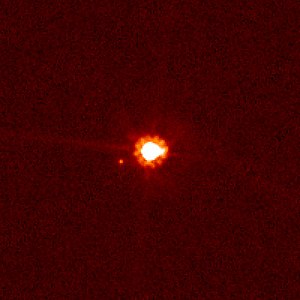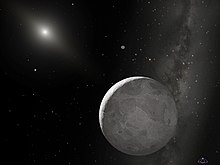Dysnomia (moon)
| Dysnomia | |
|---|---|
| Eris and her moon Dysnomia (left), photographed by the Hubble Space Telescope on August 30, 2006 | |
| Provisional or systematic name | S / 2005 (2003 UB 313 ) 1 (136199) Eris I |
| Central body | Eris |
| Properties of the orbit | |
| Major semi-axis | 37,460 ± 80 km |
| Periapsis | > 37,310 km |
| Apoapsis | <37,610 km |
| eccentricity | <0.004 |
| Orbit inclination | 61.1 ° ± 0.3 ° or 142 ° ± 3 ° |
| Orbital time | 15.772 ± 0.002 d |
| Mean orbital velocity | 0.1726 km / s |
| Physical Properties | |
| Albedo | |
| Apparent brightness | ~ 23.1 mag |
| Medium diameter | approx. 100-700 km |
| Dimensions | approx. 1.0 · 10 19 kg |
| discovery | |
| Explorer | |
| Date of discovery | September 10, 2005 |
Dysnomia is the only known satellite of the dwarf planet Eris . The estimates of the diameter vary between 100 and 700 kilometers.
Discovery and naming
Dysnomia was diagnosed by Mike Brown ( CalTech ), Chadwick A. Trujillo ( Gemini Observatory ) and David Lincoln Rabinowitz ( Yale University ) at the 10-meter Keck II telescope on Mauna Kea , Hawaii with the Laser guide star - adaptive optics -System discovered on September 10, 2005. Dysnomia was found at 0.53 ± 0.01 arc seconds from Eris, with a difference in apparent magnitude of 4.43 ± 0.05. The team of discoverers tentatively suggested the name Gabrielle , the name of the sidekick supporting role in the US television series Xena . The discovery was announced on October 4, 2005; the moon was given the provisional designation S / 2005 (2003 UB 313 ) 1 .
On September 13, 2006, the moon was officially named by the International Astronomical Union (IAU) after Dysnomia (Greek for “illegality”), the daughter of Eris and the daimona of lawlessness in Greek mythology .
The name was suggested by Michael E. Brown for several reasons. First, the tradition is taken into account, select names of associates gods to the name of the primary object, secondly, the reference to the lawlessness is (Engl. Lawlessness ) an indication of the actress Lucy Lawless plays the character of Xena the television series of the same name, the loose in Greek mythology . Brown also states that the first two letters of the name are a reference to the name of his wife Diane , whose nickname is "Di", which is why he pronounces the moon "Daisnomia" . He is referring to Pluto , whose first two letters refer to Percival Lowell's initials, who inspired and supported Clyde Tombaugh's search for Planet X , and above all to Charon , whose first four letters refer to the wife of its discoverer James W. Christy , Charlene , Clues.
In addition, Eris and Dysnomia represent aspects of chaos and thus reflect the effects that their discovery had caused, namely the subsequent controversy about the definition of a planet and in particular the debate about the status of Pluto and Ceres .
Track properties
Dysnomia orbits Eris in an almost circular orbit at a mean distance of 37,430 kilometers from its center (approx. 31 Eris radii). The orbit eccentricity is a maximum of 0.013, the orbit is 61.3 ° or 142 ° inclined to the ecliptic .
Dysnomia orbits Eris in 15 days, 18 hours and 31.7 minutes, which corresponds to around 12,909.1 orbits in one Eris year (around 557.40 earth years).
Physical Properties
Since Dysnomia has about 1/500 of the luminosity of Eris, the diameter should be about 100 kilometers. If the albedo of Dysnomia is much smaller than that of Eris, the diameter could be as much as 250 kilometers. According to other information, the diameter can even be between 350 and 490 and even up to 700 km. The moon is probably too small to have been pressed into a spherical shape by its own gravity .
Dysnomia presumably consists largely of water ice inside and thus resembles the two moons of the dwarf planet Haumea .
The team of discoverers assumes that Dysnomia was caused by an impact of a large body on Eris, analogous to the formation theory of the Earth's moon .
| year | Dimensions km | source |
|---|---|---|
| 2011 | 149.0 | Grundy et al. a. |
| 2012 |
316.0 ± 23.0 685.0 ± 50.0 |
Santos-Sanz et al. a. |
| 2018 | 700.0 ± 115 | Brown et al. a. |
| The most precise determination is marked in bold . | ||
exploration
Since its discovery in 2005, Dysnomia has been observed by terrestrial telescopes and the Hubble Space Telescope and its orbital elements have been determined. Since the albedo of the moon is still unknown, the information on the diameter of the moon is still very vague.
Since the discovery of Dysnomias, the mass of Eris has been known for its speed. Of the four known dwarf planets in the outer solar system, it was the third to have a moon. (It is now known that all have four moons.) From this one could conclude that these are not uncommon and are more common in the Kuiper Belt and beyond than in the Main Belt (approx. 10%).
See also
- List of moons from asteroids
- List of moons of planets and dwarf planets
- List of trans-Neptunian objects
- List of asteroids
swell
-
↑ a b Wm. Robert Johnston (Johnson Archives): (136199) Eris and Dysnomia . Reference there:
- "Brown, ME, and EL Schaller, 2008," The mass of dwarf planet Eris, "Science, 316: 1585, and supporting on line material."
- ↑ W. Grundy et al. a .: Five new and three improved mutual orbits of transneptunian binaries (March 2011)
- ↑ P. Santos-Sanz et al. a .: "TNOs are Cool": A Survey of the Transneptunian Region IV. Size / albedo characterization of 15 scattered disk and detached objects observed with Herschel Space Observatory-PACS (February 2012)
- ↑ M. Brown et al. a .: Medium-sized satellites of large Kuiper belt objects (January 2018)
Web links
- Mike Brown's Web page about Dysnomia (English)



